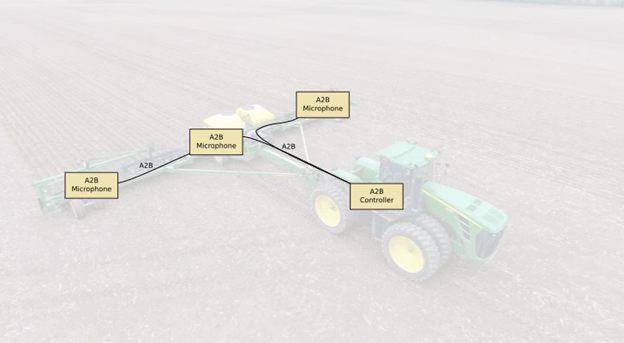Automation is creating new opportunities and challenges, disrupting industries and transforming labor markets as many organizations seek to offload the dangerous or mundane, monotonous tasks that machines already perform better and more efficiently than human employees. Despite the numerous advantages of automation, the increasing use of automated equipment across industries makes detecting faults without human operators a troubling challenge. Enter digital signal processing and A2B technology.
 From manufacturing and agriculture to transportation and healthcare, automation transforms how we work and live. But not all sensors can detect all types of faults — and adding too many sensors can cause faults themselves. Consequently, organizations across industries are seeking innovative solutions that remove humans from the loop while accurately detecting and diagnosing faults in automated systems so that people can focus on the more sophisticated and creative challenges the business faces. One such solution is our partner Analog Devices‘ digital audio bus technology, Automotive Audio Bus (A2B).
From manufacturing and agriculture to transportation and healthcare, automation transforms how we work and live. But not all sensors can detect all types of faults — and adding too many sensors can cause faults themselves. Consequently, organizations across industries are seeking innovative solutions that remove humans from the loop while accurately detecting and diagnosing faults in automated systems so that people can focus on the more sophisticated and creative challenges the business faces. One such solution is our partner Analog Devices‘ digital audio bus technology, Automotive Audio Bus (A2B).
What is A2B? A2B is a high-bandwidth, bidirectional digital audio bus that transports audio data and control information — as well as clock and power — using a single, two-wire UTP cable over distances up to 15 meters between nodes and 40 meters over the entire daisy chain.
This blog will delve into the challenges of detecting faults without human operators and implementing A2B as a fault detection solution, utilizing automated agricultural equipment as an interesting use case.
Contents
The Problem Space: Fault Detection on Automated Equipment
The increasing cross-industry reliance on automation and uncrewed equipment presents the significant challenge of detecting faults without human intervention. In the absence of human operators, mechanical system malfunctions can result in costly damages. Unlike humans who have trained ears and years of expertise in identifying and responding to equipment faults, automated equipment lacks the ability to sense and respond to issues that a human operator could easily detect.
Several significant challenges arise when trying to detect faults without human operators:
- Lack of human senses and expertise: By removing the human from the process, automated equipment can only rely on its sensors, lacking the capability to detect subtle changes or anomalies and ultimately address failures human operators often anticipate. Human experts can use their experience to detect unusual patterns or behaviors and understand the context of the fault. Without human intervention, automated equipment may miss certain types of faults or fail to accurately interpret the data, leading to false positives or negatives. Worst of all, automated systems may take longer to respond or may not respond to a problem at all.
- Limited sensors: Although sensors play a crucial role in detecting faults in automated equipment, their effectiveness can be limited due to a variety of factors. If a sensor cannot effectively capture all aspects of the equipment’s performance, detecting problems early or understanding the root cause of an issue becomes increasingly challenging, which can lead to certain faults going unnoticed. Imagine a sensor cannot capture the exact point of failure or is not sensitive enough to detect certain internal mechanical issues. That would inevitably lead to erroneous fault detection, delays in identifying the source of the problem, equipment downtime and increased maintenance costs.
- Sensor faults: Even with sensors in place, they can malfunction, leading to biased or erroneous information, false alarms, missed detections or an obscured understanding of equipment/system control and operations. This can be particularly problematic in safety-critical applications where accurate fault detection is essential for preventing accidents or other serious incidents. Additionally, sensor faults can also be costly to repair or replace, impacting the overall reliability and efficiency of the system. Therefore, robust sensor monitoring and maintenance strategies are important to detect and address any issues as quickly as possible.
- Cost and complexity: Adding more sensors to detect faults can increase the cost and complexity of the system. Installing and maintaining these sensors can be quite expensive, which can be a barrier for some organizations. Another challenge is the complexity of the technology involved. Even with the help of artificial intelligence-powered tools, accurately detecting and diagnosing faults in equipment remains difficult without a human involved in the process.
The risk of adding too many sensors is also a problem. Overloading the system with sensors can lead to an overwhelming amount of data, making identifying real faults from false positives difficult. Furthermore, too many sensors can increase the system’s complexity, leading to higher maintenance and repair costs.
The agricultural industry provides a good example of this challenge, where automated equipment may face issues related to soil quality, moisture levels and plant health. Limited sensor availability can make detecting such issues challenging, while an excess of sensors can make the system overly complicated to manage.
With A2B technology, which enables reliable communication between automated equipment and diagnostic systems, faults can be remotely detected — without the need for human intervention. This approach ensures the equipment runs efficiently and safely and helps strike a balance between sensor availability and human expertise, providing a more effective fault detection solution.
Implementing A2B Technology as a Fault Detection Solution
One of the key advantages of using digital signal processing technology for processing sounds from equipment is the ability to use multiple microphones to detect the location of sounds, which can be incredibly useful across various applications.
However, it’s important to note that simply having multiple microphones isn’t enough. You also need sensors capable of detecting failures that don’t produce noise, such as an overheating part. This is where a balance of DSP technology and an expert operator can be a powerful combination — the technology can detect potential issues while the operator uses their expertise to investigate and address them before they become expensive problems.
A2B technology provides several benefits that make it a great fit for fault detection applications, including:
- Simple wiring
- Low power consumption
- Fixed latency
- Remote control
- Low part count, and
- Ease of configuration.
Unlike other protocols that require a microprocessor in each sensor node, A2B-enabled sensors can be directly connected to the audio bus, significantly reducing system complexity and cost. Best of all, A2B is ideal for sound processing for determining sound source location.
Steps for Implementing A2B for Fault Detection
Here is a step-by-step process for implementing A2B as a fault detection solution:
- Determine the fault detection requirements of the system, such as which sensors will be used, what types of faults need to be detected and the level of accuracy required.
- Choose A2B-enabled sensors that meet the system requirements. Analog Devices offers a wide range of A2B-enabled sensors, including microphones, accelerometers, temperature sensors and more.
- Connect the sensors to the A2B bus using a standard twisted-pair cable. A2B uses a daisy-chain topology, with each sensor node connected to the bus in series.
- Configure the A2B system using the Analog Devices SigmaStudio software. SigmaStudio provides a graphical user interface for configuring A2B nodes, setting up signal chains and adjusting system parameters.
- Use SigmaStudio to design a signal processing chain that processes the sensor data to detect faults. This could include filtering, thresholding, statistical analysis or machine learning algorithms, depending on the specific requirements of the system.
- Implement the signal processing chain on the A2B-enabled microcontrollers using the SigmaStudio software.
- Test the system using a variety of fault scenarios to ensure that it meets the application’s requirements.
Implementing a robust fault detection solution using A2B technology can help provide reliable and accurate results while minimizing system complexity and cost.
Automated Agriculture: Farm Equipment as a Use Case
Automated farm equipment has revolutionized the agriculture industry, improving efficiency, accuracy and output. However, equipment failures out in the field can be costly if not detected early.
A2B technology offers an effective solution for fault detection in automated farm equipment. On the farm, time is critical, and delays due to equipment failure can result in significant losses. Worse yet, if equipment malfunctions in the field and isn’t detected in time, that can result in uneven planting, missed plants or crop damage, ultimately leading to lower yields or even crop loss. In addition, if a piece of malfunctioning equipment is not detected early, the fault may require more extensive repairs and longer downtime, leading to further delays and additional costs.
By using a main controller, a microphone array and an A2B transceiver on a tractor for fault detection, farmers can prevent equipment downtime, increase productivity and save costs associated with equipment repair and replacement.
Example A2B Sensor Configuration for Fault Detection on Automated Farm Equipment

The main controller communicates with the DSP, which processes the signals from the microphones and sends the data to the A2B transceiver. With A2B, the wiring is simple, power consumption is low and latency is fixed, making A2B technology an ideal solution for fault detection in automated farm equipment. By using A2B, farmers can identify faults quickly, thereby reducing downtime, minimizing costly repairs and maximizing crop yield.
While A2B technology shows great promise in enabling fault detection in automated farm equipment, it has the potential to be utilized in numerous other industries and applications for fault detection purposes.
Revolutionizing Fault Detection with A2B Technology
In conclusion, A2B technology offers many benefits for fault detection on automated equipment, such as simple wiring, low power consumption and ease of configuration. Compared to human operators or strictly traditional sensors, A2B provides a more comprehensive and cost-effective solution for detecting faults.
Monitoring all system sensors in real time with fixed latency and low power consumption, A2B’s simple wiring, minimal part count and simple configuration reduces costs and can detect faults that may not be detected by human operators or individual sensors alone, providing a more in-depth solution.
With the increasing use of automated equipment in various industries, implementing A2B technology for fault detection is becoming more critical. We encourage you to reach out to our A2B experts to learn more about developing an A2B solution for your automated equipment — regardless of industry.
For background and additional information, check out our other articles on A2B technology:
- What is Analog Devices’ Automotive Audio Bus (A2B) and How is It Used?
- How Does A2B Work and Where Has Cardinal Peak Used It?
- Unleashing A2B Technology For Conferencing, Live Audio And Other Applications
- Designing Audio Products with A2B and SHARC
- Taking Analog Devices A2B Technology Beyond Automotive Applications
- From GPTP To Buffer Overflow: Ensuring Seamless Automotive Audio
- Cardinal Peak Named Analog Devices Design Partner
For more information on boosting signal quality with digital signal processing, check out our blog post Improving Signal-to-Noise Ratios: How DSP Services Boost Signal Quality.
